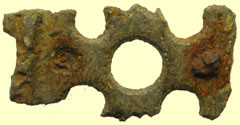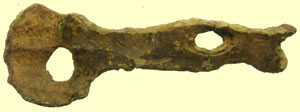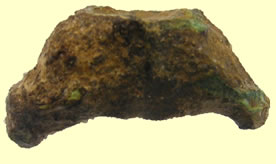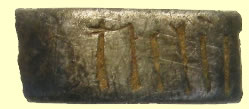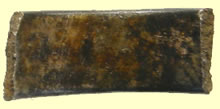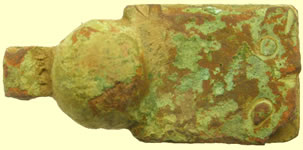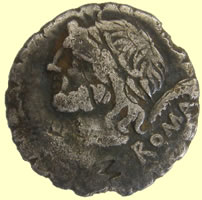

Metal detecting holidays in England with the World's most successful metal detecting club.
Twinned with Midwest Historical Research Society USA
| 2014 March finds page |
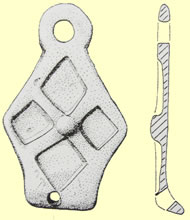  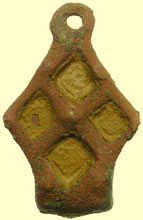 |
|||
c10thC Saxon stirrup mount type 12 - non open fretwork type , 43.56mm H Ref 302 Williams |
|||
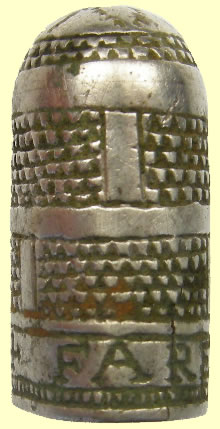 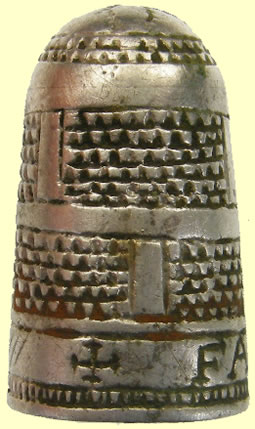   |
|||
Circa 16thC decorated silver thimble - Inscription + FARE GOD -(FEAR GOD) 5.33G, 26mm H Reported to museum as treasure |
|||
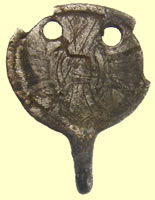    |
|||
circa 8th/9thC Saxon decorated solid silver hooked fastener used on their leg bindings Reported to museum as treasure Discussion: Hooked tags are all-purpose fasteners, used to secure small bags or purses and also clothing. They occur in various forms from the late 8th century onwards, |
|||
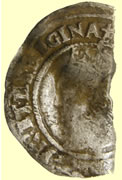  |
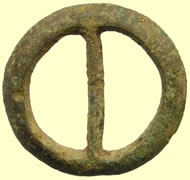 |
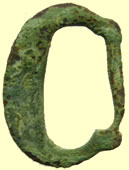 |
|
| 1578 Elizabeth 1st hammered silver sixpence | Medieval annular buckle | Early-Medieval (Anglo-Saxon) single looped buckle frame (c. 450-600). |
|
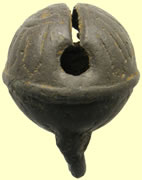 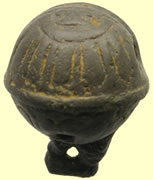 |
 |
||
| 17thC crotal bell | Royal Army Service Corp badge | ||
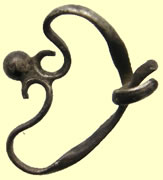  |
 |
||
| Georgian silver jewelry fragment | 18thC toy cannon | ||
|
 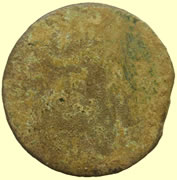 |
||
| Medieval book clasp | 1794 Colchester half penny(y) OBVERSE: A view of Colchester Castle to the edge of token. Ex: 1794. REVERSE: A weaving loom. SUCCESS TO THE BAY TRADE. EDGE: PAYABLE AT CHARLES HEATHS BAY MAKER COLCHESTER .X. |
||
 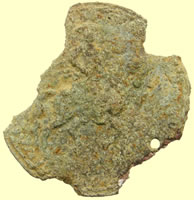 |
  |
||
18thC medallion Obv Lion facing left Rev Rider on horse |
Edwardian copper and glass stone brooch | ||
  |
  |
||
| 16thC Tudor button in stunning condition | 1500-1700 mount | ||
 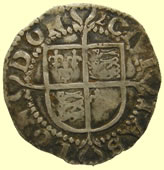 |
  |
||
| 1602 Elizabeth 1st hammered silver half groat - 2 mint mark | 1515 -59 Iorg Schultes Master, German Lion of St Mark Jetton, Lions halo projects above inner circle and interrupt legend Lion of St Mark standing left with both wings shown. Book of the Gospels between fore- paws.Halo, rising into the margin, is surrounded by a star: Rev Large Orb no initial mark, 3 pairs of annulets outside tressure Ref Mitchiner 1113 |
||
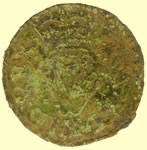 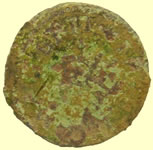 |
 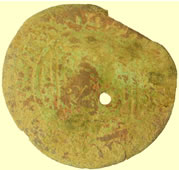 |
||
| 1603 James 1st hammered copper farthing | 1553 Hans Schultes I 'Ship penny' jetton Obv Sailing ship facing left Rev Traditional 'four fleurs in a lozenge' crown HANS rosette SCHVLTES cross PO |
||
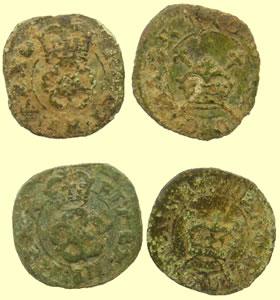  |
|||
| 1634 Charles 1st hammered copper farthings | |||
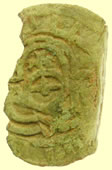 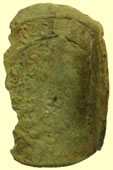 |
  |
||
1586 Hans Krauwincel II Rose orb Jetton |
1586 Hans Krauwincel II Rose orb Jetton | ||
 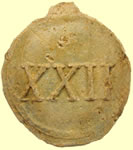 |
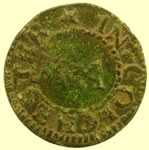 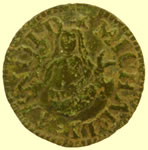 |
||
| Post medieval lead cloth seal | 17thC Michael Arnold of Colchester Essex hammered copper trade farthing Ref Norweb 1157b |
||
 |
  |
||
| 17thC Andrew Gurney of Hull crotal bell | 1871 Victoria Jersey 13th of a shilling copper coin 13th of 12 pence
|
||
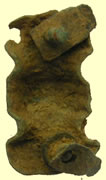  |
 |
 |
|
| 1500-1700 mount | Medieval buckle | Georgian shoe buckle | |
  |
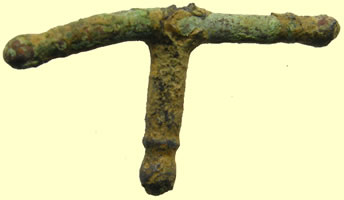 |
||
| 17thC copper thimble | Medieval harness pendant hanger | ||
 |
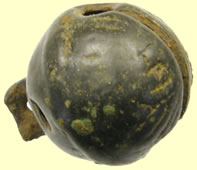 |
 |
|
| 17thC sword hanger | 17thC crotal bell | 17thC pottery | |
 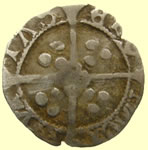 |
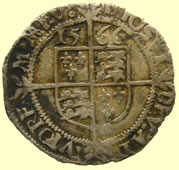  |
||
1480 -1500 Edward IV hammered silver penny - quatrefoil with pellet in reverse cross - York Archiepiscopal issue Archbishop Thomas Rotherham Type XXIv T and key by neck, star on breast Obv WDWARD DI GRA REX ANGLE Rev CIVI/TAS/EBP/RACI - York mint
|
1566 Elizabeth 1st hammered silver three pence | ||
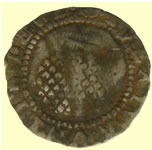 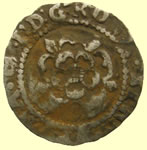 |
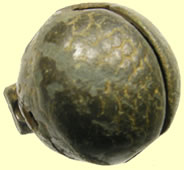 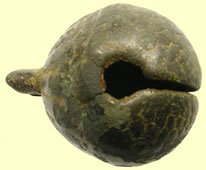 |
||
| 1603- 4 James 1st hammered silver penny - first issue | 17thc fish scale croal bell | ||
  |
 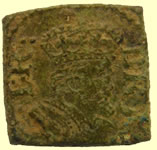 |
||
| 1586 Hans Krauwincel II Rose orb Jetton | 1604 -19 James 1st gold coin weight - Britain Crown- 2nd coinage revalued Obv VsVID (5 shillings and six pence) |
||
 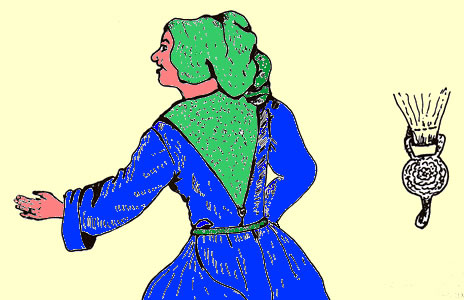 |
|||
| 16thC Tudor clothing fastener | |||
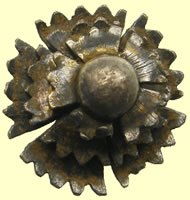 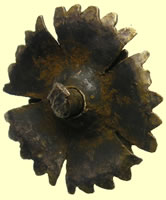 |
|||
16thC Tudor glided silver mount - reported as treasure to museum
|
|||
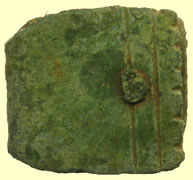  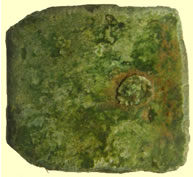 |
|||
| Medieval strap end - single rivet fixing | |||
 |
 |
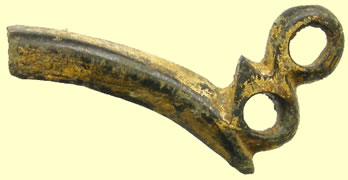 |
|
| Georgian silver fob seal mount | 16thC Tudor purse bar hanger | Georgian gilded spur fragment | |
|
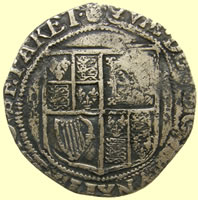 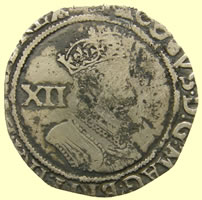 |
||
| Early medieval bar mount | 1621-3 James 1st hammered silver shilling (12 pence) | ||
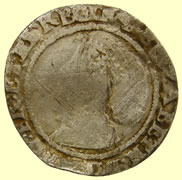 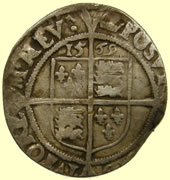 |
  |
||
| 1569 Elizabeth 1st hammered silver sixpence - Coronet mint mark | 1567-70 Elizabeth 1st hammered silver two pence - Coronet mint mark | ||
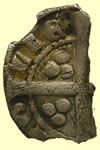 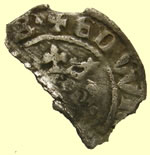 |
  |
||
1272 Edward 1st hammered silver penny Ob EDWR ANGLE DNS HYB Rev ** TO/LIE/ - Bristol mint |
1634 Charles 1st hammered copper farthings | ||
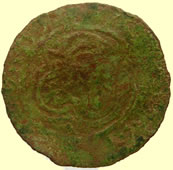  |
  |
||
| 1586 Hans Krauwincel II Rose orb Jetton | 1879 Victoria milled silver 3 pence | ||
  |
  |
||
| Medieval lead cross | 1921 George V milled silver florin - 2 shillings, 24 pence | ||
 |
 |
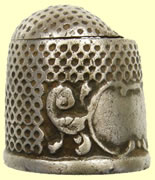 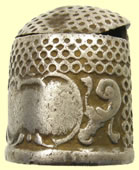 |
|
| Georgian ring pipe tamper | Glasgow Corporation and transport button | Georgian silver thimble | |
  |
|||
1725 Portuguese milled gold coin - 1600 reis 20mm,3,49g |
|||
  |
  |
||
1247 Henry III hammered silver voided long cross half penny - Class III Rev LVC/AS - Moneyer Lvcas of Gloucester or Northampton mint |
1215 Henry III hammered silver short cross half penny Rev ER.ONLV - London mint |
||
  |
 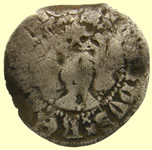 |
||
1247 Henry III hammered silver voided long cross half penny Rev /LON - London mint |
1352-53 Edward III hammered silver penny - Pre treaty D- Double stop satires Obv EDWARDVS x REX ANGLI quatrefoil with pellet in reverse cross - York Archiepiscopal issue Rev CIVI/TAS/EBO/RACI |
||
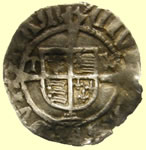 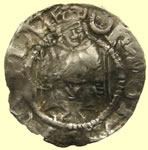 |
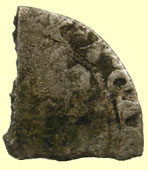  |
||
1526-44 Henry VIII hammered silver sovereign penny - (Durham) TW by shield Bishop Thomas Wolsey
|
1631 - 32 Charles 1st milled silver half crown fragment (30 pence) |
||
 |
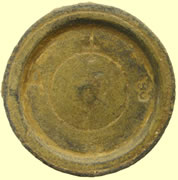 |
 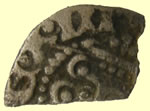 |
|
| 15thC lead token | 1247 Henry III hammered silver voided long cross half penny Rev /ONE/ - Exeter or Oxford mint |
||
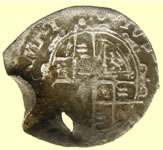 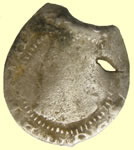 |
  |
||
| 1625 Charles 1st hammered silver penny | 1247 Henry III hammered silver voided long cross half penny Rev /ONL/ - Lincoln mint |
||
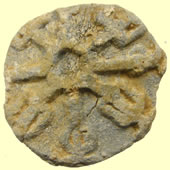 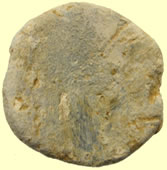 |
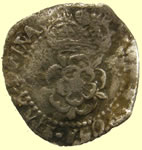  |
||
| Early medieval lead token | 1619-25 James 1st hammered silver penny | ||
 |
 |
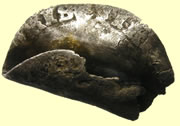 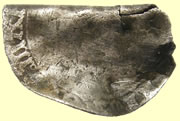 |
|
| Victorian glided silver cuff link | Victorian silver band | 1553 Mary hammered silver groat | |
 |
|||
Monster sized 18thC cow bell and size comparison to normal 18thC crotal bells Robert Well I Aldbourne 1760-1780 |
|||
 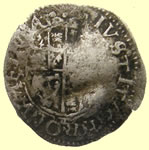 |
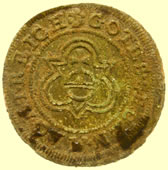 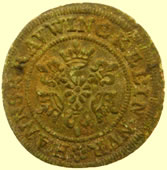 |
||
| 1625 Charles 1st hammered silver penny | 1586 Hans Krauwincel II Rose orb Jetton | ||
 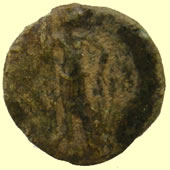 |
|||
Mid 4thC Roman bronze sent for ID This appears to be an IOVI CONSERVATORI Follis of Constantine I - not exactly a match for, but quite similar to this piece from my collection:
The first of the IOVI Folles came along half a decade or so prior to this and were significantly larger - about the same size or slightly larger than a pre-decimal shilling, or whatever has replaced it in the decimal system (10p?). By the time that yours - and the one above - came along, they had shrunk down to c. 20 mm or smaller. Yours may or may not have the eagle holding a wreath in its beak in the field - it's pretty vague on the reverse - and there were several variants in the the reverse legend as well as the ancillary types. All of them started with IOVI CONSERVATORI and then many added AVGG or AVGG NN and/or a code like CMH in ligate form - a few have Jupiter holding a lightning bolt instead of Victory on a globe, and there is huge potential variation in the mintmarks and field marks possible from over a dozen mints and more than a decade of production as the main circulating coin of its time, an eagle and/or a captive may or may not be at Jupiter's feet - but the one above is approximately the same as your coin. Of course, since the quantity of clear details is so sketchy on your coin, there is also a chance that it's from the parallel SOLI INVICTO COMITI series of Folles - issued concurrently with the IOVI's - As you can see, they both involve a deity standing to the left in the same approximate posture ("legs akimbo" you might say?) I suspect yours is more likely to be the IOVE type, but unless it can be cleaned up a little to reveal at least a few letters of the reverse legend or to make it clear which deity is portrayed, I'd go with that ID. There is also a very small chance that the figure on the reverse is supposed to be the "GENIO POPVLI ROMANI" - the allegorical personification of the motivating spirit of the Roman People who also is generally portrayed standing to the left, however, the module of those tends to be the next general size larger. There was a series of GENIO 1/4 Folles issued in 311 which would be the correct size, but Constantine was not included among the rulers portrayed on that series - and the fact that your coin portrays Constantine I, I feel very confident about from both the portrait and the parts of the legend which are legible. Also, these small-module GENIO's were only issued at the mint of Siscia in modern-day Croatia, so I suspect few specimens of that series ever made it to the shores of Britannia in antiquity. Mark |
|||
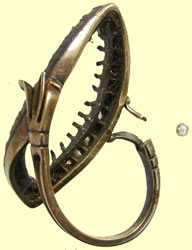 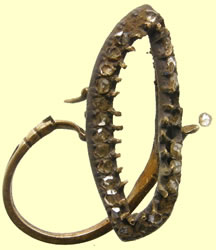 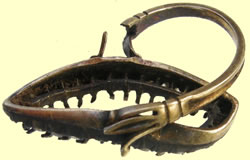  |
|||
Fascinating gold ring - no hall marks so could be early - 26 diamond/stones and 25 remain - one is loose as in the picture. They look like rough cut diamonds and all are different shapes. 16thC Tudor ?? Under my microscope the settings look very early and I cannot clean it as the stones could dislodge - reported to the museum as treasure |
|||
|
|||
| Not sure what this is - crudely decorated on shaft ?? | |||
 |
|||
| Fascinating eyeball finds - both balls are stone and too large for marbles - right hand stone looks like a miniature 'bowls' | |||
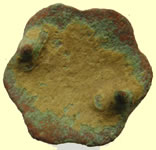 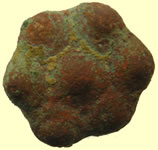 |
 |
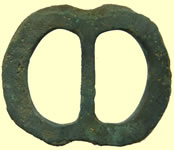 |
|
| 1500-1700 mount | Post medieval cast copper alloy asymmetrical buckle frame, some with with a pointed knop at the end of the loop The buckle dates from c.1575 - 1700 |
Post Medieval cast copper alloy single loop buckle frame. 1500-1650 AD |
|
  |
 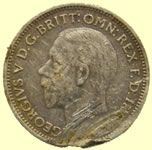 |
||
| 1603 James 1st hammered copper farthing | 1936 George V milled silver sixpence | ||
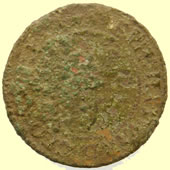 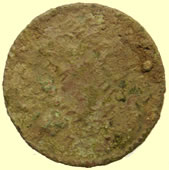 |
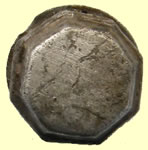  |
||
| 1586 Hans Krauwincel II Rose orb Jetton | Georgian silver stud | ||
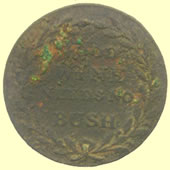 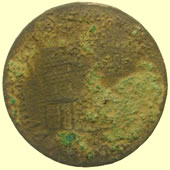 |
  |
||
Neat find 18thC token - reads obv ' Good wine needs no bush' 'British Tea Warehouse - 4 Bitter Lane' Proverb - Something good does not need to be advertised |
Fascinating coin - this purports to be an 1369-1377 Edward III hammered silver penny - Pre treaty Durham - annulet in centre of reverse cross, extra pellet in each quadrant, double satire stops and lis on breast. However the reverse legend should be CIVI/TAS/DVN/OLM but it is not a known mint. Obv EDWARDVS REX ANGLIE Rev CIA/DVR/RE*/** |
||
  |
|||
| Stunning 1500-1700 enameled mount | |||
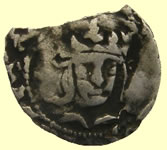  |
 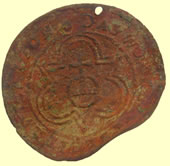 |
||
| 1435- 1438 Henry VI hammered silver penny - 2 rings in centre of reverse cross Durham mint | 1586 Hans Krauwincel II Rose orb Jetton | ||
  |
  |
||
| 1586 Hans Krauwincel II Rose orb Jetton | 1399 -1413 Henry IV hammered silver half penny - double satire stops Obv hENRIC x REX x ANGLI Rev CIVI/TAS/LON/DON - London mint |
||
 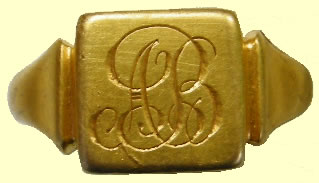 |
|||
Stunning 1851 Victorian 18 carat gold signet ring - AB Birmingham hall mark, date letter C Maker P.F.J 22mm dia , 7.30g |
|||
 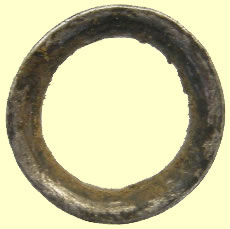  |
|||
17thC Tiny silver ring - reported as treasure 10mm dia ,0.72g Inscribed *Layer de la Hayer. in Essex |
|||
  |
 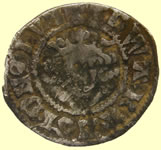 |
||
1422 -27 Henry V hammered silver penny - annulet issue , double satire stops and after TAS annulets in 2 quadrants on reverse Obv *** VS x REX x ANGLIE Rev CIVI/TASx /***/**N - London mint |
1272 Edward 1st hammered silver penny - Class 10 Obv EDWAR ANGLE DNS HYB Rev CIVI/TAS/CAN/TOR - Canterbury mint |
||
 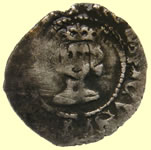 |
|
||
1377 Richard II hammered silver half penny Obv RICARDVS ****** Rev CIVI/TAS/LON/DON - London mint
0.55g, 12.5mm |
Roman bronze ring with missing stone | ||
 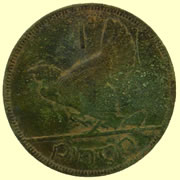 |
 |
||
| 1928 Irish Free State penny | THE ESSEX REGIMENT Formed in 1881 from The 44th. (East Essex) Regiment of Foot (1st Battalion) & The 56th. (West Essex) Regiment of Foot. (2nd Battalion). Nicknames:- "The Two Fours", "The Little Fighting Fours", "The Pompadours" & "Saucy Pompeys. |
||
 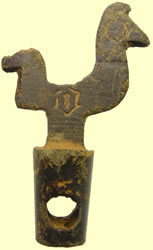  |
|||
| 15thC cockerel type barrel tap key - Foundry mark O | |||
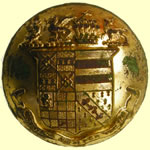 |
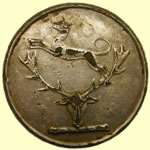 |
  |
|
| Corporation button | 19thC livery button | 1696 William III milled silver sixpence | |
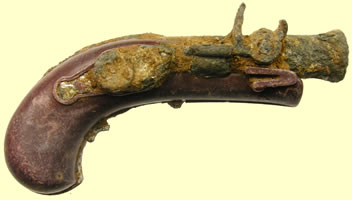  |
|||
| 20thC full size repro flint lock pistol | |||
 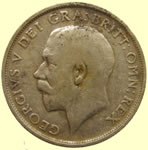 |
 |
||
| 1918 George V milled silver sixpence | WW1 Royal Artillery cap badge | ||
 |
 |
||
| Huge 18thC toy cannon | WW1 Royal Engineers cap badge | ||
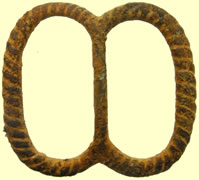 |
 |
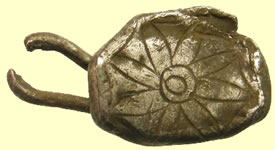 |
|
Post Medieval cast copper alloy single loop buckle frame. 1500-1650 AD |
2ndC Roman head stud fibular brooch | 18thC silver cuff link | |
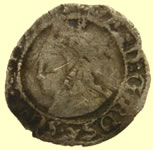  |
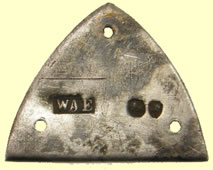  |
||
| 1567-70 Elizabeth 1st hammered silver penny | Victorian London sterling silver clothing clasp Marker WAE |
||
   |
|||
Large 1stC BC to 1st C AD Celtic bronze bucket mount 40mm H, 26.05g Here is an example of a similar one found 2012 A cast copper alloy anthropomorphic bucket mount, dating to the late Iron Age and of some rarity |
|||
 |
  |
||
1889 Victorian London sterling silver corner trim - date letter O and duty paid bust
|
1910 Edward VII milled silver sixpence | ||
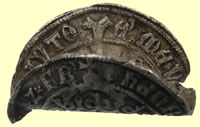 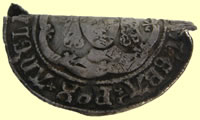  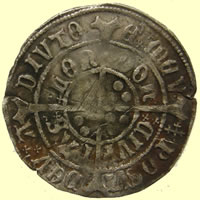 |
|||
Fixed by our goldsmith 1504- 7 Henry VII hammered silver groat - two arches unjewelled to crown, Crosslet im Obv hENRIC DI GRA REX ANGLIE Z FR Rev CIVI/TAS/LOND/DON - London mint |
|||
  |
  |
||
| 1526-44 Henry VIII hammered silver groat - Lis mint mark | 1247 Henry III hammered silver half penny Rev ORT/ - Norwich mint |
||
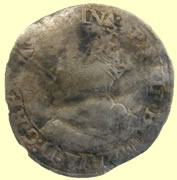  |
 |
 |
|
| 1554 -58 Phillip and Mary hammered silver groat - Lis mint mark | Roman lead token | 17thC lead token | |
 |
  |
||
| 20thC Britannia badge | 13thC medieval enamelled harness pendant - winged bird at centre | ||
  |
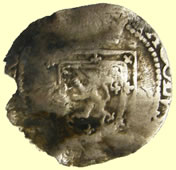 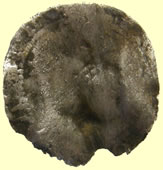 |
||
1189 Richard 1st hammered silver short cross half penny - Class 4 Rev VER+DA - Moneyer Davi of York Mint |
1601- 4 James VI of Scotland hammered silver Eighth Thistle Merk ( 20 pence) Obv IACOBUS 6 D.G.R.SCOTORUM - James VI by the grace of god king of the Scots Rev REGEM IOVA PROTEGIT 1602 - Jehovah protects the King 1602 |
||
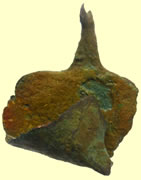 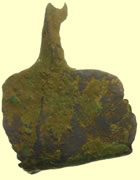 |
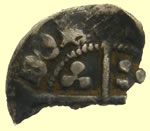 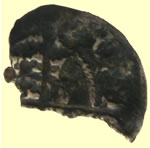 |
||
| 13thC medieval gilded harness pendant - | 1485 Henry VII hammered silver penny fragment | ||
  |
 |
 |
|
| 1880 Victoria milled silver sixpence | Medieval buckle | ||
  |
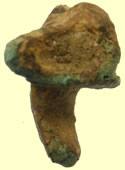 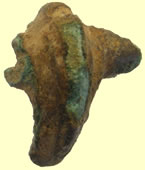 |
||
Huge 2nd C Roman fibula brooch - these thin examples are believed to be casting failures by the museum |
1stC AD Colchester type Roman fibula brooch fragment |
||
 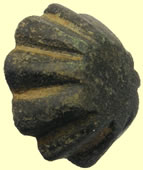 |
  |
||
| Roman mount | Medieval mount | ||
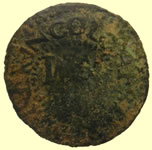  |
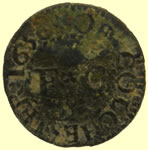 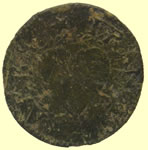 |
||
| 17thC William Moore baymaker of Colchester Essex hammered copper trade farthing | 1656 Francis Clarke of Colchester Essex hammered copper trade farthing | ||
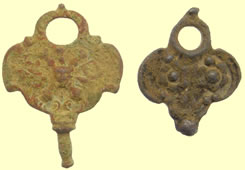 |
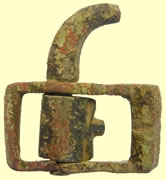 |
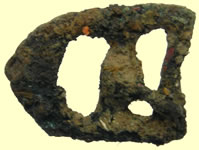 |
|
| Georgian watch winders | Georgian spur buckle | AD 1600 - 1700 buckle |
|
 |
 |
 |
|
| 1500-1700 mount | Cast copper alloy buckle of post-medieval date. The buckle is a double loop asymmetrical shape Circa 1575- 1700 |
19thC livery button | |
 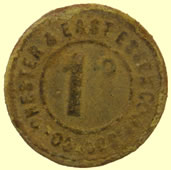 |
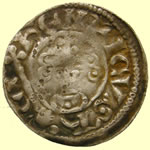 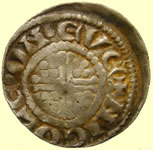 |
||
| 20thC Colchester and East Essex 1 pence token | 1199 John hammered silver short cross penny Class 5b2 Obv hENRICVS REX Rev + NICOLE .ON.EVC - Moneyer Nicole of York mint |
||
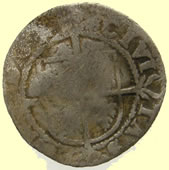 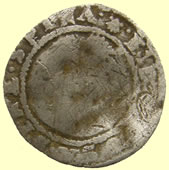 |
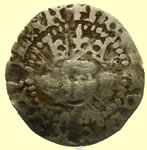  |
||
| 1584-6 Elizabeth 1st hammered silver half groat | 1413-1422 Henry V hammered silver penny - mullet and annulet by crown Type D Obv +hENRIC DI GRA REX ANG Rev CIVI/TAS/LOND/DON - London mint |
||
  |
|||
| Huge 1817 George III milled silver half crown (30 pence) | |||
  |
 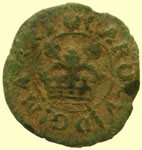 |
||
Taco'd 1272 Edward 1st hammered silver penny Rev CIVI/TAS/LOND/DON - London mint |
1634 Charles 1st hammered copper rose farthing | ||
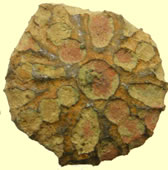  |
 |
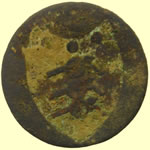 |
|
| Roman mount | Cast copper alloy buckle of post-medieval date. The buckle is a double loop asymmetrical shape Circa 1575- 1700 |
Royal artillery button | |
|
|||
| 13thC Medieval hook with lombardic inscription on its face | |||
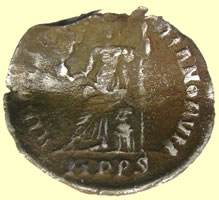  |
|||
5thC Roman hammered silver coin sent for ID 1.08g, 20mm dia It's obviously Theodosius - you can read his name quite easily. The question remains, though, "which Theodosius?" Theodosius I who was part of what I like to call "The Valentinian Dynasty" reigned during the late 4th century. His dates were 379-395. Then there's Theodosius II from 402-450. This one - VIRTVS ROMANORVM - with Roma seated left holding Victory and spear with mint mark MDPS would be Theodosius I from the Mint of Milan. These are not easily datable to specific years or groups of years - the same type was minted throughout his reign and during several others including that of Theodosius II. Theo II, however, did not strike at Milan - and his coins are far scarcer. The references for your piece are RIC IX 32a and RSC 57b. Mark |
|||
  |
|||
Monster sized coin - 1894 Alfonso Spanish 5 Pesetas milled silver coin 19.79g, 36mm dia |
|||
 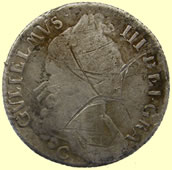 |
 |
||
| 1697 William III milled silver shilling - Coventry mint | Size comparison with a 5 pesetas and a shilling | ||
 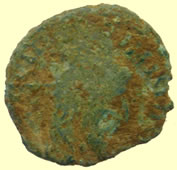 |
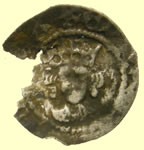  |
||
| 4thC Roman bronze coin sent for ID | 1483 Edward IV hammered silver half penny 2nd reign - Heraldic cinquefoil mint mark London mint |
||
 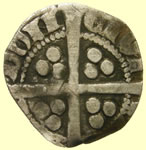 |
  |
||
1272 Edward 1st hammered silver penny Rev CIVI/TAS/LOND/DON - London mint |
Taco'd 1247 Henry III hammered silver voided long cross penny | ||
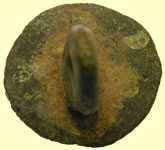  |
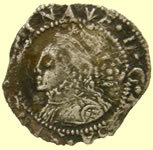  |
||
| 16thC Tudor button | 1561 Elizabeth 1st hammered silver penny - Pheon mint mark | ||
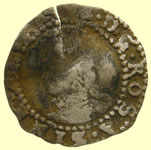 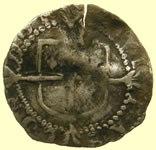 |
 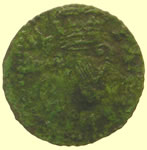 |
||
| 1584-6 Elizabeth 1st hammered silver penny - Pheon mint mark | 1603 James 1st hammered copper farthing | ||
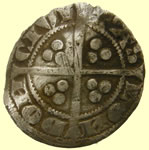  |
  |
||
1272 Edward 1sthammered silver penny - Type 1c Obv EDW REX ANGLE DNS HYB Rev CIVI/TAS/LOND/DON - London mint |
1217/8 Henry III hammered silver short cross halfpenny - Type 7a 7b Rev ELIS ON ** - Moneyer Elis of London mint |
||
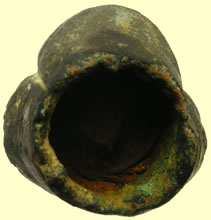   |
|||
| Medieval sword pommel | |||
  |
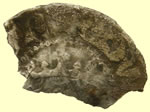 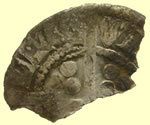 |
||
| Medieval hammered silver coin fragment | Medieval Edward hammered silver penny fragment Villa type coin |
||
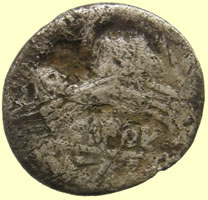 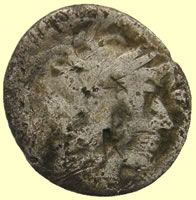 |
|||
Circa 100 BC Roman republican silver sent for ID - needs a 'cook' to reveal more detail
Plenty adequate detail to ID it, at least. Cn. Foulvius, M. Calidus & Q. Metellus - 117-116 BC - Helmeted head of Roma right / Victory in biga right, holding wreath; beneath, CNFOVL (CNF & VL ligate), M. CAL • Q. MET (CAL & MET ligate) in exergue. |
|||
 |
 |
||
| Medieval book clasp | Georgian silver buckle tongue | ||
 |
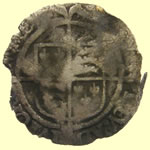  |
||
| Gilded and decorated Roman widget ? | 16thC Elizabeth 1st hammered silver half groat | ||
 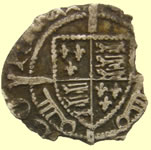 |
  |
||
1485 Henry VII hammered silver sovereign penny - Keys by shield - Archbishop Rotherham - no pillars to throne York mint |
1247 Henry III hammered silver voided long cross half penny | ||
 |
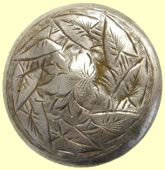  |
||
| 15thC copper thimble | Victorian silver faced mount - maker CW | ||
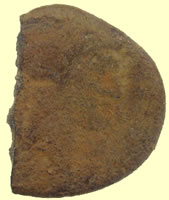 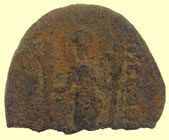  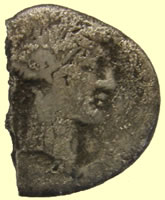 |
|||
| BC Roman republican silver coin - cooking to remove crust and sent for ID I found a second to go looking for an ID for this one. I was quite a bit off on my first estimated date - dating to 42 BC, it's right on the cusp of the Republican & Imperial periods. The family is Claudia (Babelon/RSC Claudia 15). The obverse is Apollo, head right (should be a lyre behind the head, but that would have been on the missing bit.) The reverse is Diana Lucifera standing holding two torches, with P•CLODIVS downwardly on the right, and M•F• (illegible) to the left. Crawford 494/23; Sydenham 1117; SRCV 492. Mark http://www.stoa.org/gallery/album98/ML_31_Clodia_den |
|||
 |
 |
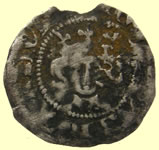 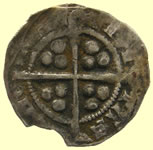 |
|
| Georgian watch winder | 17thC jug fragment | 1272 Edward 1st hammered silver penny Rev CIVI/TAS/EBO/RACI - York mint |
|
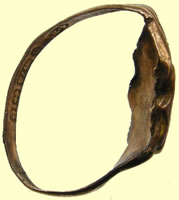 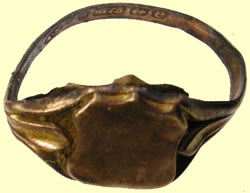 |
|||
| 1904 Birmingham 9 carat rose gold ring - Marker AH | |||
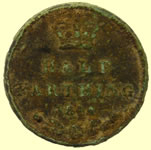 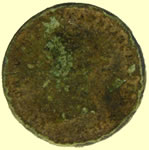 |
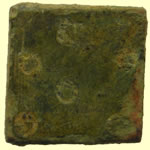 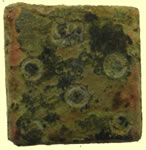 |
||
| 1844 Victorian copper half farthing | 18thC bullion weight - Lion mark | ||
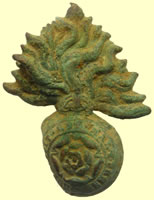 |
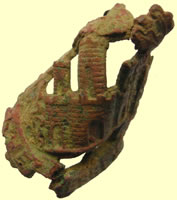 |
  |
|
Royal fuseliers cap badge |
THE ESSEX REGIMENT Formed in 1881 from The 44th. (East Essex) Regiment of Foot (1st Battalion) & The 56th. (West Essex) Regiment of Foot. (2nd Battalion). Nicknames:- "The Two Fours", "The Little Fighting Fours", "The Pompadours" & "Saucy Pompeys. |
1778 Russian lead bale seal | |
 |
 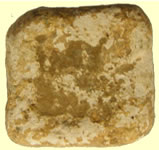 |
||
| 1887 - The Queen's Own Worcestershire Hussars were formed in 1794, as the Worcestershire Yeomanry, when King George III, was on the throne | Medieval bullion weight | ||
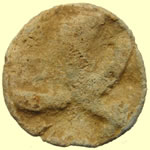  |
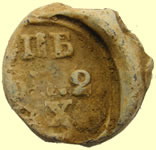 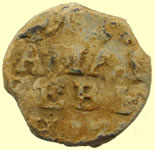 |
||
| 17thC lead token | 18thC Russian lead bale seal | ||
  |
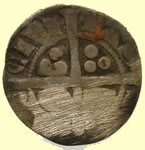  |
||
1216 Henry III hammered silver short cross half penny Class 7a to 7b Rev ER OF RO - Moneyer Roger of R - Canterbury mint |
1272 Edward 1st hammered silver penny | ||
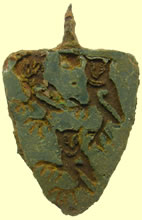 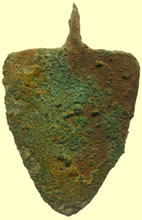 |
|||
Stunning 13thC medieval heraldic harness shield pendant A medieval copper alloy horse harness pendant, shield-shaped, red enamel survives. Gules three owls ?Or/Argent. Possibly for Sir Richard BERMINGHAM, Gules three huits (owles in margin, L) Argent (Papworth 1874, rep. 1985, p. 329). Inscription: Gules three owls ?Or/Argent.
|
|||
  |
 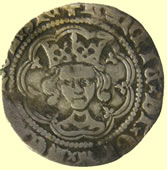 |
||
1216 Henry III hammered silver short cross half penny Class 7b Square A Rev + RICAR - Moneyer Ricard of London mint |
1422 -30 Henry VI hammered silver half groat - annulet issue - 2 annulets in 2 quadants in reverse qtrs. 9 arches to tressure, fleurs on cusps, none over crown. Obv +hENRIC x DI x GRA x REX ANGLIE Z FR Rev CIVI/TAS/LOND/DON - London mint |
||
 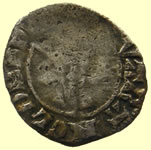 |
  |
||
1272 Edward 1st hammered silver penny Ob EDWAR ANGL DNS HYB Rev CIVI/TAS/D ** - Durham mint |
1665 William Ferris of Colchester Essex hammered copper trade farthing | ||
 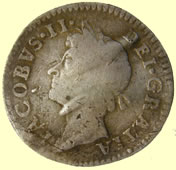 |
|||
| Very rare early milled find 1687 James II milled four pence | |||
 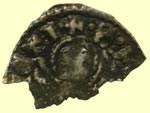 |
 |
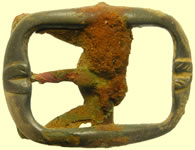 |
|
| 14thC Venetian soldino hammered silver coin | 17thC clothing fastener | Post medieval cast copper alloy rectangular two piece buckle C1650-1725 |
|
 |
 |
 |
|
Cast copper alloy buckle frame 1500 -1700 |
Medieval buckle with integral plate | ||
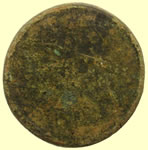  |
 |
||
| 1770's coin weight - £3 12 shillings | UNITED KINGDOM Royal London Yacht Club R. T. Y. C. - R. T. Y. C. London, England In use 1837 - 1901 |
||
 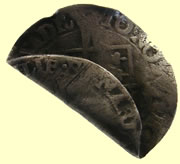 |
  |
||
| 1553 Mary hammered silver groat | 1891 Victoria milled silver sixpence | ||
 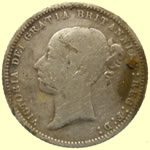 |
 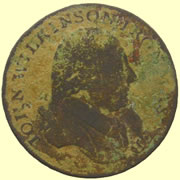 |
||
| 1862 Victoria milled silver sixpence | 1792 Trade copper Condor Token John Wilkinson Iron Master | ||
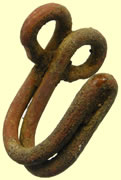 |
 |
 |
 |
| 17thC clothing fastener | 15thC casket key | 1500-1700 mount | 16thC Tudor fretwork button |
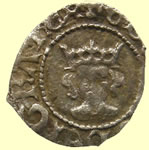 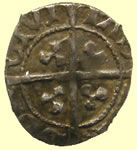 |
|
||
1471- 83 Edward IV hammered silver half penny - 2nd reign Obv + ED **** DEI GRA REX Rev CIVI/TAS/LOND/DON - London mint |
Medieval silver finger ring with lombardic lettering - reported to museum as treasure - Edward III type initial mark | ||
  |
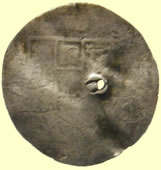 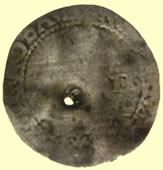 |
||
1247 Henry III hammered silver half penny Rev ONL/VND- London mint |
1616-17 James 1st hammered silver half groat | ||
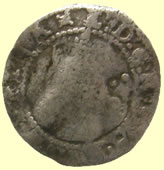  |
 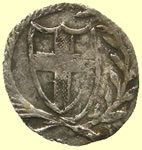 |
||
| 1592-5 Elizabeth 1st hammered silver half groat | 1649 Commonwealth hammered silver penny | ||
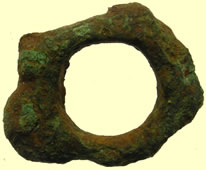 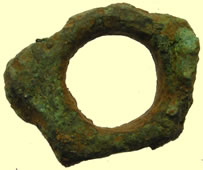 |
 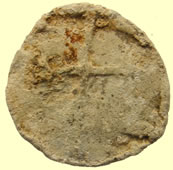 |
||
| C10thC Saxon harness cheek piece fragment | Medieval lead Boy Bishop token | ||
 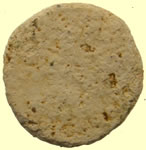 |
  |
||
| Medieval lead coin weight | 1704 Anne milled silver sixpence | ||
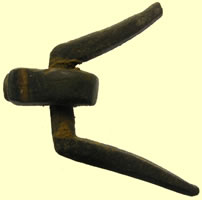 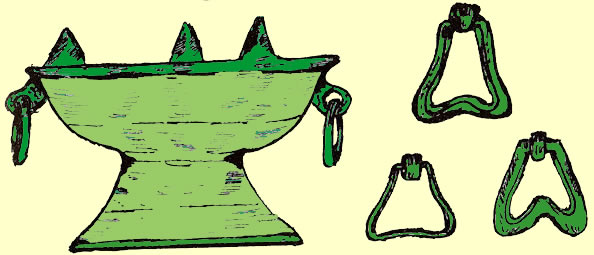 |
|||
Medieval Chaffing dish handle |
|||
 |
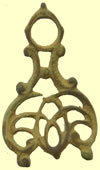 |
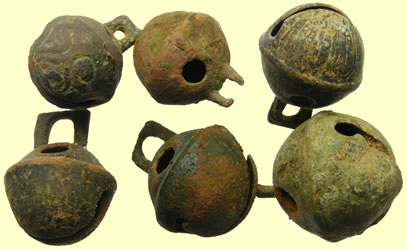 |
|
| 17thC clothing fastener | Georgian fob seal holder | Loads of great 16th to 18thC crotal bells turning up | |
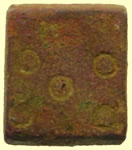 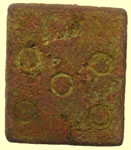 |
  |
||
| 18thC bullion weight - Lion mark | 1851 Victoria milled silver 3 pence | ||
  |
 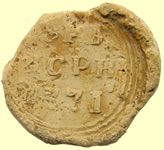 |
||
| Victorian silver cord end | 1771 Russian lead bale seal | ||
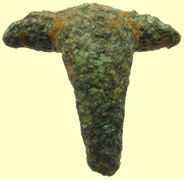 |
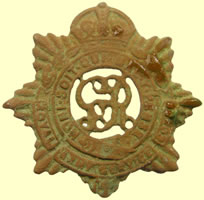 |
  |
|
| 2ndCRoman fibular brooch | WWI Royal Army Service Corp badge | 1327 Edward III hammered silver penny - Cross 3 Obv EDWR ANGL D *** Rev CIVI/TAS/L** - London mint |
|
  |
 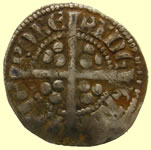 |
||
| 1215 Henry III hammered silver short cross penny fragment | 1280-1289 Edward 1st hammered silver penny Obv EDWR ANGL DNS HYB Rev ROBE/RTDE/HADE/LEIE - moneyer Robert de Hadelie of Bury St Edmunds mint |
||
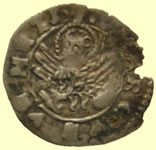  |
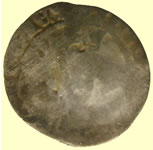 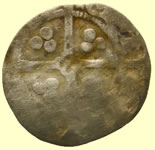 |
||
Venetian Soldino issued by Doge Michele Steno (1400-1413). Doge standing left, holding banner, * / m in right field
|
1272 Edward 1st hammered silver penny Quatrefoil with pellet at centre of reverse cross - York mint Archiepiscopal issue |
||
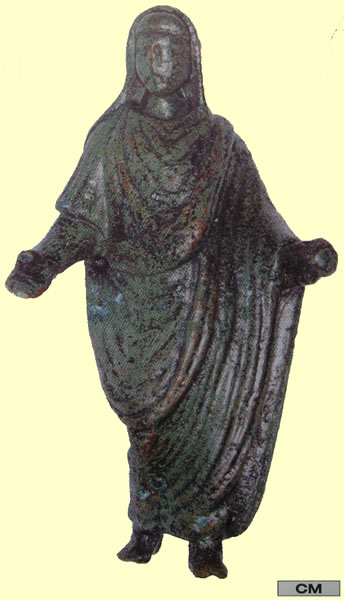 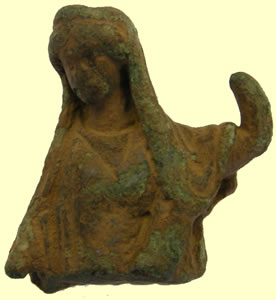 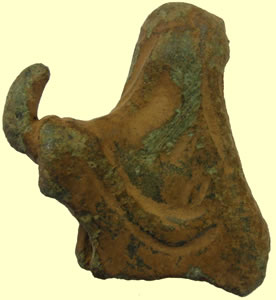 |
|||
Roman veiled standing togate figure - popular throughout the Roman Empire but quit a rare find in Britain 50mm high The small size of the statue, the thin profile of the head and upper body, and the somewhat Augustan or Julio-Claudian traits reflected in the face all indicate that the statue was made, probably as a public or personal votive offering, in a central Italian workshop, such as that which produced the large votive bronzes from Nemi. |
|||
  |
 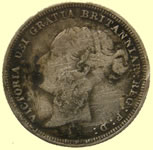 |
||
1272 Edward 1st hammered silver penny - Class 10C Obv EDWAR ANGL DNS HYB Rev CIVI/TAS/LON/DON - London mint |
1885 Victoria milled silver sixpence | ||
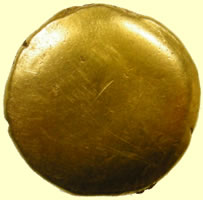 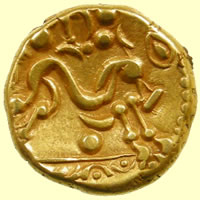 |
|||
Beautiful strike of a 50 BC Gallo Belgic full Celtic gold stater sent to CCI for recording 16mm,6.28g |
|||
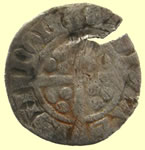 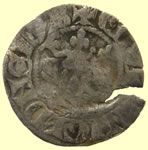 |
 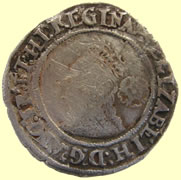 |
||
1272 Edward 1st hammered silver penny - Class 3 egg wasted S Obv + EDWAR ANGL' DNS HYB Rev CIVI/TAS/LON/DON - London mint |
1594-6 Elizabeth 1st hammered silver sixpence | ||
 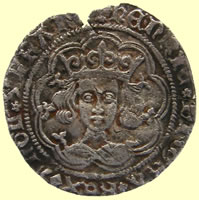 |
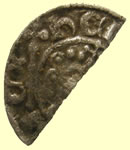  |
||
1427-30 Henry VI hammered silver groat - Rosette Mascle issue- Inital mark incurved pierced cross - rosettes and mascles in obverse legend obv HENRIC DI GRA REX ANGLIE Z FRANCE Rev inner VILLA CASTISIE - Calais mint Rev outer - POSVI DEVM ADIVTORE MEVM
3.51g, 27.07mm |
1199 John hammered silver silver short cross halfpenny - Class 5a Obv hENRICVS REX Rev ONGI + AL - Moneyer Alisandre of Ipswich mint |
||
  |
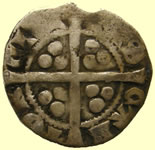  |
||
| 1868 Victoria milled silver shilling (12 pence) | 1272 Edward 1st hammered silver penny Obv + EDWAR ANGL DNS HYB Rev CIVI/TAS/CAN/TOR- Canterbury mint |
||
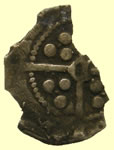  |
  |
||
1461 - 1483 Irish Edward IV hammered silver penny - D at centre pf reverse cross, crosses by neck
|
1189 Richard 1st hammered silver silver short cross halfpenny - Class 3-4a Obv hENRICVS REX Rev VND + AIM - Moneyer Aimer of London mint |
||
  |
 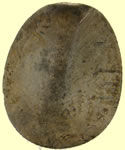 |
||
Venetian Soldino issued by Doge Michele Steno (1400-1413). Doge standing left, holding banner, * / T in right field |
Victorian milled silver sixpence | ||
 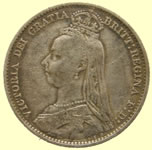 |
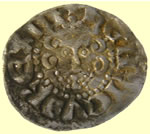  |
||
| 1892 Victoria milled silver sixpence | 1247 Henry III hammered silver voided long crosss penny - Class IIIb Obv hENRICVS REX III Rev NIC/OLE/ONL/VND - Moneyer Nicole of London mint |
||
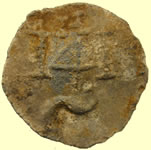  |
 |
||
| 17thC lead token | Georgian buckle | ||
 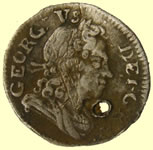 |
|||
Tiny 1723 George 1st milled silver one pence 12mm, 0.49g |
|||
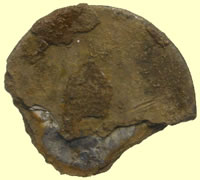 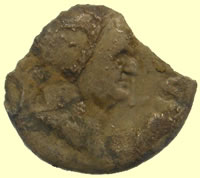 |
|||
2ndC Roman silver coin sent for initial ID and straight into the 'cooker' to remove crust At this point, and with as much of the coin missing and encrusted as we see here, I can only say that it most likely is one of 3 emperors. Galba - in which case it's scarce and in demand, or one of the Flavians - Vespasian or Titus (it doesn't look at all like Domitian). This puts it in a rather tight temporal window. 68-81 AD. There really wasn't anyone else that jowly and corpulent - at least who was portrayed on his coins that way. Let me see it when it comes out of treatment and perhaps I can tell you more about it. Mark |
|||
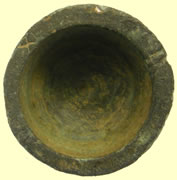 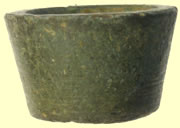 |
 |
||
| 18thC bullion cup weight with XD on the rim | 17thC Charles 1st/2nd trade weight - Crown C cipher | ||
 |
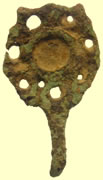 |
 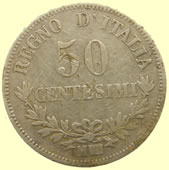 |
|
| 17thC clothing fastener | 16thC Tudor clothing fastener | Italy 1863 Vittorio Emanuele II milled silver 50 centesimi | |
  |
  |
||
| Mid 4thC House of Constantine Roman bronze coin - two soldiers standing | 1553 Mary hammered silver groat | ||
   |
|||
| Early medieval gilded and circle decorated harness pendant | |||
 |
 |
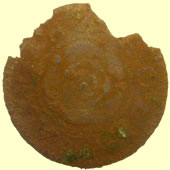  |
|
| 17thC sword hanger | 1500-1700 mount | 17thC hammered copper 'His Half Penny' trade token | |
1741 Admiral Vernon medallion |
|||
Obv Legend curving above says "THE . PRIDE . OF . SPAIN + HUMBLED . BY . AD VERNON". There is no line enclosing the legend. Along the bottom (in exergue) is the legend "AND SR CHAL" and on the next line "OGLE". A full length Vernon is on the left, facing 3/4 to the right, wearing a tricorn hat; his left hand is extended and in his right hand he is receiving the sword of Don Blass. Don Blass is on the right and facing left (towards Admiral Vernon), and is on his left knee. His right hand is handing his sword to Admiral Vernon and his left hand is holding his hat behind him. Behind Don Blass stands Sir Chaloner Ogle with a baton in his right hand, and the left on his hip. In the field above Don Blass's head is the legend "DON BLASS". The medal has a plain raised edge. Rev Legend curving along the top says "THEY TOOK CARTAGENA APRIL 1741". There is a line enclosing the legend. Two ships are sailing left towards a fort in the foreground on the right. Two forts in the middle are connected by a chain boom, behind which is a boat. Above the boat in two lines is the legend "DON" and "BLASS". In the background the city of Cartagena is portrayed in a straight line across the medal. A steeple points between the "C" and the "A". A tower in the center points at the central "A" in "CARTAGENA". A tower at the right is pointing right of the last "A" in "CARTAGENA". The medal has a plain raised edge. |
|||
 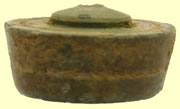 |
|
||
| Georgian trade weight | Late medieval hooked strap end | ||
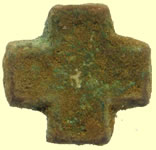 |
 |
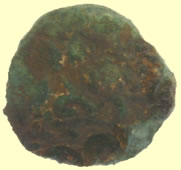 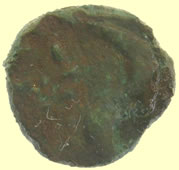 |
|
| Medieval mount | 1500-1700 mount | Ancient bronze coin - could be either Celtic or Roman so I sent off for Mark Lehmans views Perhaps the core of a fourree Celtic gold or electrum stater with a very abstract design? Otherwise it really doesn't look like anything I'm familiar with. I can run it past some folks who might have a better idea, if you'd like. Mark |
|
ID'd as 106 BC |
|||
One of the best condition c100 BC Roman Republican silvers I have seen dug, minimal cleaning to remove crust. Sent to Mark Lehman for ID - 3.36g, 17.56mm
That's a nice one - and it's actually a rare sub-type of this otherwise fairly common denarius. Usually a Memmia 2 will have a control letter either beneath the chin on the obverse or below the horses on the reverse. Those without a control letter - like this one - are fairly scarce. Although it's not immediately apparent, this is a "serrate" denarius - it has a toothed edge. Coins of this type vary geatly in the depth and number of indentations around the edges even among a single type and it is theorized that groups of 10 or so flans were clamped together and a file was used to cut serrations in the edges of all of them at once, pre-striking. This technique could - and did - produce great variations in number of teeth and the depth of the indentations around the edges. It seems that this piece never had particularly deep serration to begin with and wear, etc, has obscured the serration even further on this specimen. What is less understood is just why they bothered to add this very labor-intensive step to the minting process, and only on a few - less than 10% - of the types. One leading theory used to be that this was done as a protection against the fourree type of forgery where a copper core was wrapped in thick silver foil which was "soldered" onto the core with an acid flux and heat, then struck. Cutting the edge of a coin was one way to check to see if it had a copper core and so some thought these to have been produced as "pre-cut" to prove that they were silver all the way through. However, it is easily shown that fourrees are just as common among serrati as in the usual, smooth-edged types, which kills that theory fairly quickly. this is an example of a fourree serrate denarius from my collection: Another popular theory is that these were for some reason favored by the Gauls and other "tribal" folk to the north where they were more readily accepted in trade than smooth-edged pieces - why this might have been, however, is never explored. Finally, there's the old "Istanbul/Constantinople" explanation - they might have done it just because they liked them that way - or to make them purposefully different. For a young and ambitious senator, being a aedile moneyer was a difficult and thankless task which was a typical first step on the cursus honorum - the "ladder" by which those senators with political aspirations beyond their participation in the Senate advanced in a career quest the evenual goal of which was to become a Censor or Consul with great power and access to riches. In order to make a name for oneself as an aedile moneyer one method was to produce coins which were in some way different or memorable - but without going too far out-of-bounds in terms of the accepted designs - and in that way serration may have been one step as a part of a political "arms race" among aediles to create "more unique" types. Mark |
|||
 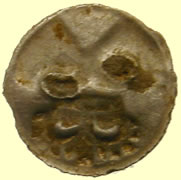 |
  |
||
| 17thC Charles II silver button - reported as treasure to museum | 1247 Henry III hammered silver voided long cross half penny Rev OIC/ONL - Unknown moneyer - London or Lincoln mint |
||
  |
  |
||
1247 Henry III hammered silver voided long cross half penny- Class 3a Rev OlN/ION - Moneyer - Ion of Lincoln mint |
Early silver cord end - reported as potential treasure to museum | ||
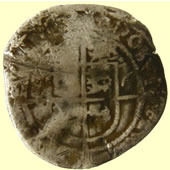 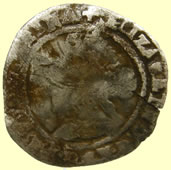 |
  |
||
| 1578-9 Elizabeth 1st hammered silver three pence - Greek cross mint mark | 1351 Edward III hammered silver penny - Pre treaty or Post Treaty Obv *** LI+ Rev /DV** - Durham mint |
||
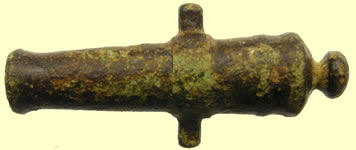 |
 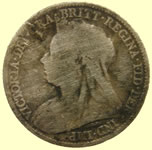 |
||
| 18thC toy cannon | 1894 Victoria milled silver sixpence | ||
 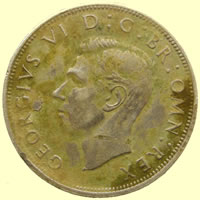 |
 |
||
| 1945 George VI milled silver half crown (30 pence) | Georgian spur | ||
 |
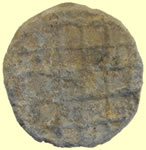 |
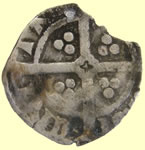 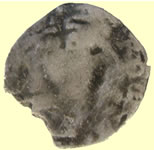 |
|
| 18thC button | 17thc lead token | 1327 Edward III hammered silver penny - Quatrefoil with pellet at centre of reverse cross - Archiepiscopal issue Obv ** RD G Rev CIVI/TAS/***/**CI - York mint |
|
 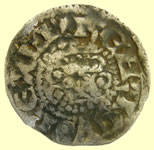 |
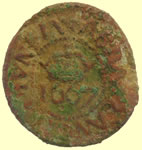 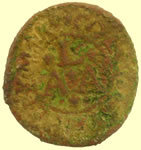 |
||
1247 Henry III hammered silver voided long cross penny- Class IIIb Obv hENRICVS REX III' Rev NIC/OLE/ONW/INC - Moneyer -Nicole of Winchester mint |
1667 Alaba Langley, bay maker of Colchester Essex hammered copper trade farthing | ||
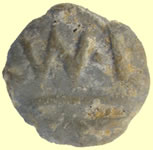 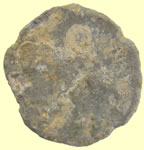 |
  |
||
| 17thC lead token | 1887 Victoria copper half farthing | ||
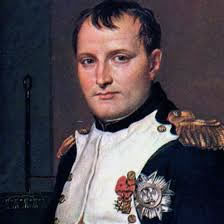  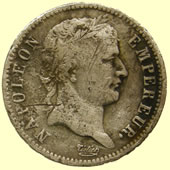 |
|||
Napoleon Bonaparte France 1 franc 1812 Utrecht Netherlands - French in occupation 1810 -1813 Designer Pierre Joseph Tiolier Mintage 12,000
Small lead Napoleon figurine
|
|||
|
|||
